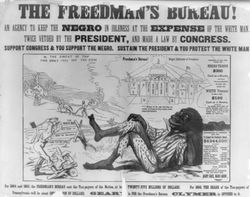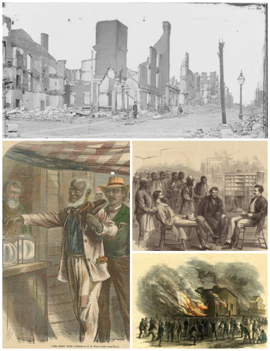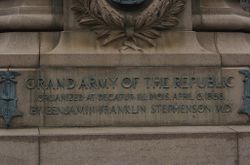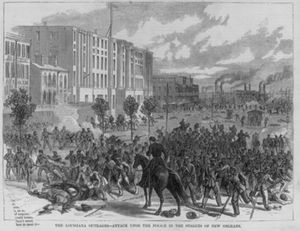عصر إعادة البناء
| |||||||||
| |||||||||
عصر إعادة البِناء Reconstruction era مرحلة في تاريخ الولايات المتحدة الأمريكية أعقبت الحرب الأهلية التي وقعت في الفترة ما بين (1861- 1865م). وفي أثناء تلك المرحلة استعاد اتحاد الولايات الشمالية علاقاته بالولايات المتحالفة في الجنوب، بعد هزيمة الولايات الجنوبية في الحرب الأهلية. استمرت مرحلة البناء للدولة الجديدة منذ 1865م وحتى 1877م.
واجه قادة الشمال والجنوب في تلك المرحلة مشاكل معقدة كثيرة، منها على سبيل المثال، كيف يسمح للإحدى عشرة ولاية الجنوبية التي انسحبت من الاتحاد بالعودة مرة أخرى؟ وكيف يعاقب قادة التحالف؟ وما الحقوق التي يجب أن تمنح للعبيد المحررين بعد الحرب؟ وكيف يمكن حماية تلك الحقوق؟
الدمار المادي للجنوب في 1865
مشروع لنكولن

اقترح الرئيس أبراهام لنكولن، أنه إذا أقسم 10% من الناخبين في الولايات، أن يعضدوا ويؤازروا الاتحاد، فإنه يمكن تأليف حكومة جديدة، وطلب أن ينص الدستور الجديد على إلغاء الرق. لكن بعد أقل من أسبوع من انتهاء الحرب الأهلية وفي 9 أبريل 1865م اغتيل الرئيس لنكولن وحل محله نائب الرئيس أندرو جونسون ليكون رئيسًا للدولة.
مشروع جونسون
أصدر جونسون عفوًا عامًا عن كل البيض الجنوبيين، فيما عدا قادة التحالف الرئيسيين، وينص المشروع على أن تؤلف الولايات الجنوبية حكومات جديدة، تقوم بإلغاء الرق وتأخذ على نفسها عهدًا بالولاء للوطن، لكي تكون مؤهلة للعودة إلى الاتحاد. ولم يمنح المشروع السود دورًا في بناء الدولة الجديدة.
القوانين الخاصة بالسود
أصبح وضع السود أكثر المشاكل صعوبة وتعقيدًا للحكومة الجديدة، فقد سنَّت تلك الحكومة عدة قوانين عرفت باسم المدونة السوداء، تم بمقتضاها تمكين الجنوبيين البيض من السيطرة والتحكم في العبيد المحررين، حيث ظل ضرب الرقيق المحررين بالسياط معمولاً به، وكان على السود أن يوقعوا عقودًا للعمل بالسخرة لمدة عام، ويمكن أن يودع العاطلون منهم في السجن. بالإضافة إلى ذلك فإن السود عانوا من الهجمات العنيفة التي كان يشنها عليهم البيض الذين رفضوا أن يتعاونوا مع حكومات الدولة الجديدة.
اعتبر الكثير من الجنوبيين البيض أن الحكومات الجديدة غير قانونية، فلم يوافقوا على فكرة حق الانتخاب للسود، ولا على شغلهم وظائف حكومية. وتأسست منظمة سرية للبيض تسمى كوكلوكس كلان في تنسي. كانت مهمة كلان محاربة السود وذلك بضربهم أو حتى قتلهم، ومهاجمة كل من يتعاطف معهم من البيض.
سياسات الدولة الجديدة وبرامجها

أسست الدولة الجديدة ـ ولأول مرة ـ مدارس مدعومة ومعفاة من الضرائب في معظم ولايات الجنوب فاندفع السود نحوها، لكن الكثيرين من البيض رفضوا الالتحاق بها، وكان من نتيجة ذلك أن أصبحت تلك المدارس معزولة عنصريًا. لذلك ألغيت بحكم القانون.
وقد حرمت الحكومات الجديدة التفرقة العنصرية ومنحت السود حق الانتخاب، لكن عنف البيض حرم السود من أن يجنوا ثمار أي حق من حقوقهم بصورة حقيقية، على الرغم من حماية القانون لهم عن طريق فرق مسلحة من الشمال.
جابهت حكومات الجنوب مشاكل ومصاعب اقتصادية كبرى. فالزراعة مثلاً كانت تسير ببطء بعد الحرب، وقليل من الجنوبيين من كان عنده المال الكافي لإنشاء صناعات جديدة، لذا كان من المحتم جذب رؤوس الأموال من الشمال وتشجيعها على الاستثمار في الجنوب. وقبل أن تنجز الأهداف الكاملة لحكومات الدولة الناشئة جاءت انتخابات الرئاسة عام 1876م برذرفورد هايز على رأس الدولة، فأسرع في تنفيذ خطة لسحب فرق الحماية المسلحة من الجنوب.
إعادة إلحاق الولايات المنفصلة بالتمثيل في الكونگرس
- تنسي - July 24, 1866
- أركنسا - June 22, 1868
- فلوريدا - June 25, 1868
- نورث كارولينا - July 4, 1868
- ساوث كارولينا - July 9, 1868
- لويزيانا - July 9, 1868
- ألباما - July 13, 1868
- ڤرجينيا - January 26, 1870
- مسيسيپي - February 23, 1870
- تكساس - March 30, 1870
- جورجيا - 15 يوليو 1870
شاغلو المناصب العامة من السود
| Race of delegates to 1867 state constitutional conventions | ||||
| الولاية | البيض | السود | % البيض | في كل الولاية البيض التعداد (% in 1870)[3] |
|---|---|---|---|---|
| ڤرجينيا | 80 | 25 | 76 | 58 |
| كارولينا الشمالية | 107 | 13 | 89 | 63 |
| كارولينا الجنوبية | 48 | 76 | 39 | 41 |
| جورجيا | 133 | 33 | 80 | 54 |
| فلوريدا | 28 | 18 | 61 | 51 |
| ألباما | 92 | 16 | 85 | 52 |
| مسيسپي | 68 | 17 | 80 | 46 |
| لويزيانا | 25 | 44 | 36 | 50 |
| تكساس | 81 | 9 | 90 | 69 |
المصدر: Rhodes (1920) v 6 p. 199; لا تقرير عن أركنسا
There were very few African Americans elected or appointed to national office. African Americans voted for white candidates as well as for blacks. The Fifteenth Amendment guaranteed the right to vote, but did not guarantee that the vote would be counted or the districts would be apportioned equally. As a result, even states with majority African American population often only had one or two African American representatives in Congress, except for South Carolina. At the end of Reconstruction, four of its five Congressmen were African American.
| السود في مناصب عامة 1870-1876 | |||
| الولاية | مشرعو الولايات | شيوخ وطنيون | نواب وطنيون |
|---|---|---|---|
| ألباما | 69 | 0 | 4 |
| أركنسا | 8 | 0 | 0 |
| فلوريدا | 30 | 0 | 1 |
| جورجيا | 41 | 0 | 1 |
| لويزيانا | 87 | 0 | 1* |
| مسيسيپي | 112 | 2 | 1 |
| كارولينا الشمالية | 30 | 0 | 1 |
| كارولينا الجنوبية | 190 | 0 | 6 |
| تنسي | 1 | 0 | 0 |
| تكساس | 19 | 0 | 0 |
| ڤرجينيا | 46 | 0 | 0 |
| Total | 633 | 2 | 15 |
| See E. Foner, Reconstruction: America's unfinished revolution, 1863-1877 (NY: Harper & Row, 1988), pp. 354-5.
A list of the 15 African American Representatives elected during Reconstruction | |||
المدارس الحكومية

الضرائب أثناء اعادة البناء
| نسب ضرائب الولايات على الممتلكات أثناء إعادة البناء | ||
| Year | ساوث كارولينا | مسيسيپي |
| 1869 | 5 mills (0.5 %) | 1 mill (0.1 %) (lowest rate between 1822 and 1898) |
| 1870 | 9 mills | 5 mills |
| 1871 | 7 mills | 4 mills |
| 1872 | 12 mills | 8.5 mills |
| 1873 | 12 mills | 12.5 mills |
| 1874 | 10.3-8 mills | 14 mills (1.4%) "a rate which virtually amounted to confiscation" (highest rate between 1822 and 1898) |
| 1875 | 11 mills | |
| 1876 | 7 mills | |
| Source | J. S. Reynolds, Reconstruction in South Carolina, 1865-1877, (Columbia, SC: The State Co., 1905) p. 329. | J. H. Hollander,Studies in State Taxation with Particular Reference to the Southern States, (Baltimore: Johns Hopkins Press, 1900) p. 192. |
الخلاص 1873-1877
الجمهوريون ينقسمون: انتخابات 1972
التحالف الجمهوري يتشظى في الجنوب
الديمقراطيون يجربون "مغادرة جديدة"

بريشة توماس ناست
كرتون سياسي عن (Wheeler) Compromise في لويزيانا
نـُشر في هارپرز الأسبوعية
6 مارس 1875
ذعر 1873
The Panic of 1873 (a depression) hit the Southern economy hard and disillusioned many Republicans who had gambled that railroads would pull the South out of its poverty. The price of cotton fell by half; many small landowners, local merchants and cotton factors (wholesalers) went bankrupt. Sharecropping for black and white farmers became more common as a way to spread the risk of owning land. The old abolitionist element in the North was aging away, or had lost interest, and was not replenished. Many carpetbaggers returned to the North or joined the Redeemers. Blacks had an increased voice in the Republican Party, but across the South it was divided by internal bickering and was rapidly losing its cohesion. Many local black leaders started emphasizing individual economic progress in cooperation with white elites, rather than racial political progress in opposition to them, a conservative attitude that foreshadowed Booker T. Washington.[4]
Nationally, President Grant was blamed for the depression; the Republican Party lost 96 seats in all parts of the country in the 1874 elections. The Bourbon Democrats took control of the House and were confident of electing Samuel J. Tilden president in 1876. President Grant was not running for re-election and seemed to be losing interest in the South. States fell to the Redeemers, with only four in Republican hands in 1873, Arkansas, Louisiana, Mississippi and South Carolina; Arkansas then fell after the violent Brooks–Baxter War in 1874 ripped apart the Republican party there.
العنف
انتخابات 1876
هايز ينهي إعادة البناء
On January 29, 1877 President Grant signed the قانون المفوضية الانتخابية which set up a 15-member commission to settle the disputed 1876 election of 8 Republicans and 7 Democrats. The Electoral Commission awarded Rutherford B. Hayes the electoral votes he needed; Congress certified he had won by one electoral vote. The Democrats had little leverage—they could delay Hayes' election but they could not put their man (Tilden) in the White House. However they agreed not to block Hayes' inauguration based on a "back room" deal. Key to this deal was the understanding that federal troops would no longer interfere in southern politics despite substantial election-associated violence against blacks. The Southern states indicated that they would protect the lives of African Americans although this obviously turned out to be far from reliable. Hayes's friends also let it be known that he would promote Federal aid for internal improvements, including help for a railroad in Texas (this never happened) and name a Southerner to his cabinet (this did happen). With the end to the political role of Northern troops, the President had no method to enforce Reconstruction, thus this "back room" deal signaled the end of American Reconstruction.[5]
آثار مرحلة إعادة البناء ونتائجها
في أثناء مرحلة إعادة البناء تحقق الآتي: أعيد توحيد الولايات وأعيد بناء الجنوب من جديد. عمقت الأنظمة التعليمية التي أسست في الجنوب أهمية هذا الإقليم. ومع ذلك فإن الدولة الجديدة لم تنجح في حل مشاكل السود بوجه خاص ومشاكل الجنوب بوجه عام، كما أخفقت في تحقيق التجانس العنصري بين ولايات الجنوب. وفقد السود تدريجيًا ما اكتسبوه من حقوق. ولم يكن السود الأمريكيون قادرين حتى على المطالبة بالمساواة بالبيض، قبل منتصف القرن التاسع عشر وقبل صدور القانون الذي وعدتهم به حكومات عصر إعادة البناء.
اعادة البناء - ولاية بولاية – التواريخ الهامة
Only Georgia has a separate article about its experiences under Reconstruction. The other state names below link to a specific section in the state history article about the Reconstruction era.
| Article on Reconstruction in each State | Seceded from Union | Joined Confederacy | Readmitted into Union | Democratic Party Establishes Control |
|---|---|---|---|---|
| South Carolina | December 20, 1860 | February 4, 1861 | July 9, 1868 | April 11, 1877 |
| Mississippi | January 9, 1861 | February 4, 1861 | February 23, 1870 | January 4, 1876 |
| Florida | January 10, 1861 | February 4, 1861 | June 25, 1868 | January 2, 1877 |
| Alabama | January 11, 1861 | February 4, 1861 | July 14, 1868 | November 16, 1874 |
| Georgia | January 19, 1861 | February 4, 1861 | July 15, 1870 | November 1, 1871 |
| لويزيانا | January 26, 1861 | 4 فبراير 1861 | June 25 or July 9, 1868 | January 2, 1877 |
| تكساس | February 1, 1861 | March 2, 1861 | March 30, 1870 | January 14, 1873 |
| Virginia | April 17, 1861 | 7 مايو 1861 | January 26, 1870 | October 5, 1869 |
| Arkansas | 6 مايو 1861 | May 18, 1861 | June 22, 1868 | November 10, 1874 |
| North Carolina | May 21, 1861 | May 16, 1861 | July 4, 1868 | November 28, 1870 |
| Tennessee | June 8, 1861 | May 16, 1861 | July 24, 1866 | October 4, 1869 |
الهامش
- ^ "The First Vote" by William Waud Harpers Weekly Nov. 16, 1867
- ^ انظر [1] based America's Reconstruction: People and Politics After the Civil War, by Eric Foner and Olivia Mahoney. Online source is: [2]
- ^ The statistics of the population of the United States, embracing the tables of race, nationality, sex, selected ages, and occupations. To which are added the statistics of school attendance and illiteracy, of schools, libraries, newspapers, periodicals, churches, pauperism and crime, and of areas, families, and dwellings Table 1. United States Census Bureau. Last Retrieved 2007-10-20
- ^ Foner pp. 545–7.
- ^ C. Vann Woodward, Reunion and reaction: the compromise of 1877 and the end of reconstruction (1956), pp. 3–15
المصادر
- Barnes, William H., ed. History of the Thirty-ninth Congress of the United States. (1868) useful summary of Congressional activity.
- Barney, William L. Passage of the Republic: An Interdisciplinary History of Nineteenth Century America (1987). D. C. Heath ISBN 0669047589
- Berlin, Ira, ed. Freedom: A Documentary History of Emancipation, 1861–1867 (1982), 970 pp of archival documents; also Free at Last: A Documentary History of Slavery, Freedom, and the Civil War ed by Ira Berlin, Barbara J. Fields, and Steven F. Miller (1993)
- Blaine, James.Twenty Years of Congress: From Lincoln to Garfield. With a review of the events which led to the political revolution of 1860 (1886). By Republican Congressional leader
- Donald, David H. et al. Civil War and Reconstruction (2001), standard textbook
- Fitzgerald, Michael W. Splendid Failure (2007) Historical analysis of the Reconstruction and politics involved. ISBN 978-1-56663-734-3
- Fleming, Walter L. Documentary History of Reconstruction: Political, Military, Social, Religious, Educational, and Industrial 2 vol (1906). Uses broad collection of primary sources; vol 1 on national politics; vol 2 on states
- Ford, Lacy K., ed. A Companion to the Civil War and Reconstruction. (2005). 518 pp
- Memoirs of W. W. Holden (1911), North Carolina Scalawag governor
- Hyman, Harold M., ed. The Radical Republicans and Reconstruction, 1861-1870. (1967), collection of long political speeches and pamphlets.
- Lynch, John R. The Facts of Reconstruction. (New York: 1913)Full text online One of first black congressmen during Reconstruction.
- Edward McPherson, The Political History of the United States of America During the Period of Reconstruction (1875), large collection of speeches and primary documents, 1865-1870, complete text online. [The copyright has expired.]
- Palmer, Beverly Wilson and Holly Byers Ochoa, eds. The Selected Papers of Thaddeus Stevens 2 vol (1998), 900pp; his speeches plus and letters to and from Stevens
- Palmer, Beverly Wilson, ed/ The Selected Letters of Charles Sumner 2 vol (1990); vol 2 covers 1859-1874
- Pike, James Shepherd, The prostrate state: South Carolina under negro government (1874)
- Reid, Whitelaw. After the war: a southern tour, May 1, 1865 to May 1, 1866. (1866) by Republican editor
- Charles Sumner, "Our Domestic Relations: or, How to Treat the Rebel States" Atlantic Monthly September 1863, early Radical manifesto
الصحف والمجلات
- DeBow's Review major Southern conservative magazine; stress on business, economics and statistics
- Harper's Weekly leading New York news magazine; pro-Radical
- Nast, Thomas. magazine cartoons pro-Radical editorial cartoons
- Primary sources from Gilder-Lehrman collection
- The New York Times daily edition online through ProQuest at academic libraries
للاستزادة
For much more detail see Reconstruction: Bibliography
- Brown, Thomas J., ed. Reconstructions: New Perspectives on Postbellum America (2006) essays by 8 scholars excerpt and text search
- Du Bois, W.E.B. Black Reconstruction in America 1860-1880 (1935), Counterpoint to Dunning School explores the economics and politics of the era from Marxist perspective
- Du Bois, W.E.B. "Reconstruction and its Benefits," American Historical Review, 15 (July, 1910), 781—99 online edition
- Dunning, William Archibald. Reconstruction: Political & Economic, 1865-1877 (1905). Influential summary of Dunning School; blames Carpetbaggers for failure of Reconstruction. online edition
- Fitzgerald, Miachael W. Splendid Failure: Postwar Reconstruction in the American South (2007), 224pp; excerpt and text search
- Walter Lynwood Fleming The Sequel of Appomattox, A Chronicle of the Reunion of the States(1918). From Dunning School[3].
- Foner, Eric and Mahoney, Olivia. America's Reconstruction: People and Politics After the Civil War. ISBN 0-8071-2234-3, short well-illustrated survey
- Foner, Eric. Reconstruction: America's Unfinished Revolution, 1863-1877 (1988) ISBN 0-06-015851-4. Pulitzer-prize winning history and most detailed synthesis of original and previous scholarship.
- Foner, Eric. Forever Free: The Story of Emancipation and Reconstruction. 2005. 268 pp.
- Ford, Lacy K., ed. A Companion to the Civil War and Reconstruction. Blackwell, 2005. 518 pp.
- Franklin, John Hope. Reconstruction after the Civil War (1961), 280 pages. ISBN 0226260798. Explores the brevity of the North’s military occupation of the South, limited power of former slaves, influence of moderate southerners, flaws in constitutions drawn by Radical state governments, and reasons for downfall of Reconstruction.
- Henry, Robert Selph. The Story of Reconstruction (1938).
- Jenkins, Wilbert L. Climbing up to Glory: A Short History of African Americans during the Civil War and Reconstruction. SR Books, 2002. 285 pp.
- Litwack, Leon. Been in the Storm So Long (1979). Pulitzer Prize; social history of the Freedmen
- McPherson, James and James Hogue. Ordeal By Fire: The Civil War and Reconstruction (2009)
- Milton, George Fort. The Age of Hate: Andrew Johnson and the Radicals. (1930). online edition; from Dunning School
- Perman, Michael. Emancipation and Reconstruction (2003). 144 pp.
- Randall, J. G. The Civil War and Reconstruction (1953). Long the standard survey, with elaborate bibliography
- Rhodes, James G. History of the United States from the Compromise of 1850 to the McKinley-Bryan Campaign of 1896. Volume: 6. (1920). 1865-72; Volume: 7. (1920). 1872-77; Highly detailed narrative by Pulitzer prize winner; argues was a political disaster because it violated the rights of white Southerners. vol 6 1865-1872 online; vol 7 online vol 6 online at Google.books vol 7 in Google.books
- Richardson, Heather Cox. West from Appomattox: The Reconstruction of America after the Civil War (2007)
- Simpson, Brooks D. The Reconstruction Presidents (2009)
- Stalcup, Brenda. ed. Reconstruction: Opposing Viewpoints (Greenhaven Press: 1995). Uses primary documents to present opposing viewpoints.
- Stampp, Kenneth M. The Era of Reconstruction, 1865-1877 (1967); short survey; rejects Dunning School analysis.
- Stampp, Kenneth M. and Leon M. Litwack, eds. Reconstruction: An Anthology of Revisionist Writings," (1969), essays by scholars
- Trefousse, Hans L. Historical Dictionary of Reconstruction Greenwood (1991), 250 entries
انظر أيضاً
وصلات خارجية
- Reconstruction: The Second Civil War 2004 PBS film and transcript connecting the replacement of Civil Rights with segregation at the end of 19th century Reconstruction with 1960s Civil Rights Movement.
- Guide to Reconstruction History links to primary and secondary sources
- PBS' American Experience: Reconstruction Historians Eric Foner, David Blight, and Ed Ayers discuss "Civil Rights During Reconstruction"
- Proclamation of August 1866, declaring the Insurrection at an end.
- Lincoln and Freedom: Reconstruction
- Reconstruction in Mississippi by Donald J. Mabry
- "Reconstruction Historiography: A Source of Teaching Ideas" by Robert P. Green, Jr. (1991)
- W. S. Simkins, "Why the Ku Klux," 4 The Alcalde (June 1916): 735-748. online
- The Civil War: Reconstruction: This is part of an extensive assessment of the Civil War and slavery which gives particular attention to children.
- HIST 119: The Civil War and Reconstruction Era, 1845-1877 with Professor David Blight. Full semester course in text/audio/video from Open Yale Courses. Materials free under the Creative Commons license.
- Aftermath of war
- تاريخ الحقوق المدنية في الولايات المتحدة
- تاريخ الحقوق المدنية للأمريكان الأفارقة
- فترة إعادة البناء
- الولايات المتحدة الجنوبية
- تاريخ حقوق التصويت في الولايات المتحدة
- تعويضات عن العبودية
- American military occupations
- African-American history between emancipation and the Civil Rights Movement
- عقد 1860 في الولايات المتحدة
- عقد 1870 في الولايات المتحدة









